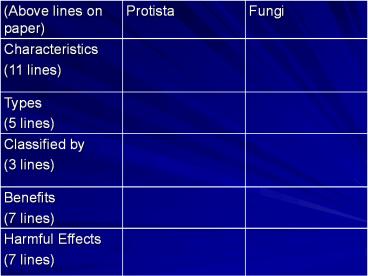PROTISTS - PowerPoint PPT Presentation
1 / 54
Title:
PROTISTS
Description:
Title: PROTISTS Author: Mindy Last modified by: SHACKELFORD, MALLORY Created Date: 1/16/2006 10:34:26 PM Document presentation format: On-screen Show (4:3) – PowerPoint PPT presentation
Number of Views:156
Avg rating:3.0/5.0
Title: PROTISTS
1
(Above lines on paper) Protista Fungi
Characteristics (11 lines)
Types (5 lines)
Classified by (3 lines)
Benefits (7 lines)
Harmful Effects (7 lines)
2
Kingdom ProtistaProtists
- I. Characteristics
- All are eukaryotic
- Most are unicellular /some are multicellular
- Asexual or sexual reproduction
- Autotrophic or heterotrophic
- Can be grouped into 3 general categories by the
way they obtain nutrition
3
Draw this in the TYPES column
4
Animal like Protists Protozoans
- A. Heterotrophs-do not make their own food
- B. Classified by means of movement
5
False feet pseudopods
Animal like Protists Protozoans
- C. Projections of their cytoplasm (false feet)
- Most harmless, but some cause dysentery
6
amoeba-can cause amoebic dysentery
Animal like Protists Protozoans
7
Lime skeleton formed the white cliffs of Dover
Animal like Protists Protozoans
8
Animal like Protists Protozoans
- D. Move by flagella (whip-like tail)
- Beneficial example -
Trichonympha live in gut of termites-help
termite digest wood
9
Parasitic
Animal like Protists Protozoans
- a. Trichomonas-
- causes STD venereal disease
b. Giardia-freshwater, causes dysentery
10
Trypanosoma-African sleeping sickness-carried by
tsetse fly
Animal like Protists Protozoans
11
PARAMECIUMmove by cilia
Animal like Protists Protozoans
12
Paramecium
Animal like Protists Protozoans
13
E. Sessile
Animal like Protists Protozoans
- 1. Do not move on their own (sessile)
- 2. All are parasitic-carried by an insect (insect
is the vector) - 3.Example-Plasmodium in saliva glands of
mosquito, causes Malaria
14
MALARIA
Animal like Protists Protozoans
15
Animal like Protists Protozoans
MALARIA
16
- Animal - like Protist Videos
- https//www.youtube.com/watch?vaWItglvTiLc
- http//youtu.be/7pR7TNzJ_pA
- http//youtu.be/StqUDFDtye4
17
Plant-like protists
- A. Autotrophs-photosynthetic-make their own food
- B. Classified by
- Color
- Photosynthetic pigments
- Whether they are unicellular or multicellular
18
C. Unicellular Algae
Plant-like protists
19
golden algae
Plant-like protists
- a. Cell walls of silica
- b. Example- Diatoms
- Benefits - Cleaners, toothpaste, filters
(diatomaceous earth) - Makes up phytoplankton
- Direct and indirect food source for ocean animals
- Produce large amount of oxygen (50-70)
- Source of offshore oil deposits
- Autotrophic-bottom of the food chain
20
Diatoms
Plant-like protists
https//www.youtube.com/watch?v0z-zBy3UQQE
21
Dinoflagellata
Plant-like protists
- Phytoplankton
- 2 flagella
22
D. Bioluminescent-produce light
Plant-like protists
23
Plant-like protists
- red tide a bloom that forms toxins
- bloom enormous growth
- Depletes water of nutrients
- Decomposes dead cells removing oxygen from water
- Fish and other organisms die
24
RED TIDE
Plant-like protists
25
EuglenaUsed in sewage treatment plantsCan
cause blooms in pond water
Plant-like protists
26
E. Algae-
Plant-like protists
- autotroph-contain chlorophyll and accessory
pigments that can give color - Classified by color
27
Green Algae
Plant-like protists
- evolved into 1st land plants
- Examples
- unicellular-Chlamydomonas
28
Plant-like protists
- Volvox-colonial
29
spirogyra
Plant-like protists
30
Red Algae
Plant-like protists
- Benefits - Used to thicken
- soup, pudding, frosting.
- Thickener is carageenan
31
Plant-like protists
Benefits - Used to make nori (sushi wrap)
32
Brown algae
Plant-like protists
- Kelp largest brown seaweed
- - used to thicken ice cream
33
d. Sargassum makes up the Sargasso Sea
Plant-like protists
34
Fungus-like protistsSlime and Water Molds
- A. Decompose matter in soil
35
Water molds
Fungus-like protists
- Caused
- Great Potato Famine
36
Slime Molds
Fungus-like protists
- https//www.youtube.com/watch?vvmp1uopZKz8
- http//www.scientificamerican.com/article.cfm?idb
rainless-slime-molds - https//www.youtube.com/watch?vczk4xgdhdY4
- https//www.youtube.com/watch?v75k8sqh5tfQ
- https//www.youtube.com/watch?vCIEggUBoivY
37
KINGDOM FUNGI
38
I. Characteristics
- Eukaryotic,
- Heterotrophic,
- Cell walls made of chitin
- B. Decomposers, some are parasitic
- C. Classified by their fruiting body how they
produce spores
39
Fruiting Bodies
40
Hyphae basic structural unit
Mycelium mass of tangled hyphae
41
Bread Mold used in cortisone production
Mycelium mass of tangled hyphae
42
- Yeasts used in baking and brewing (unicellular)
- fermentation product CO2
- Remember balloon lab in the fall
43
Truffles - edible
Morel - edible
44
- Bracket Fungi
45
Mushrooms-some are food
46
Rusts/Smuts-- destroy cereal crops
47
Amanita Deathcapvery poisonous
48
Puffballs
49
- Benefits -
- Penicillium makes antibiotic
- gives bleu cheese the blue veins
50
-makes citric acid and soy sauce -used to
produce cyclosporin (anti-rejection drug for
transplant patients)
51
Harmful Effects Responsible for athletes
foot, ringworm, jock itch, thrush
52
VI. Symbiotic Relationshipclose association of 2
organisms
- Lichen algae (makes food) fungus (traps
moisture) - used to detect air pollution
- B. Mycorrhizae
- plant roots (feeds fungus)
- fungus (gives water and minerals)
53
Decomposition
- https//www.youtube.com/watch?v8uHxRwQqWFo
- https//www.youtube.com/watch?v3AZKixtQz_Q
- https//www.youtube.com/watch?vQ36_8s5z6S8
54
What to know about protists and fungi
- General characteristics
- Examples
- How they are classified
- Benefits
- Harmful effects































